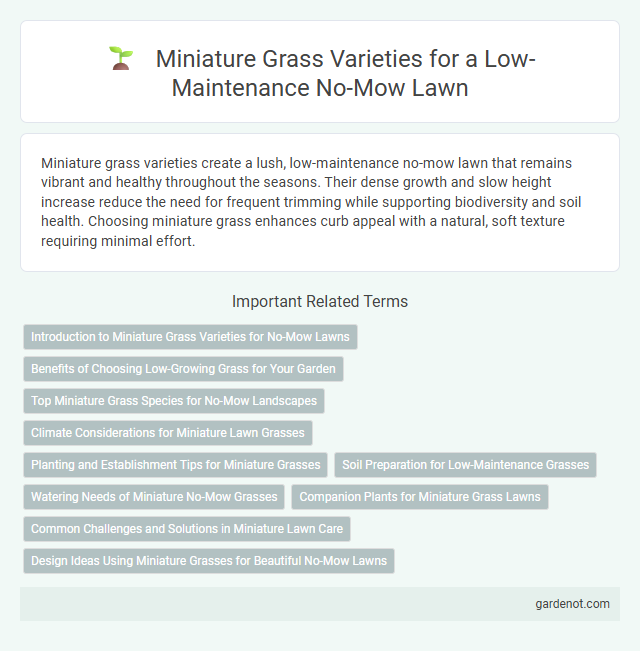Miniature grass varieties create a lush, low-maintenance no-mow lawn that remains vibrant and healthy throughout the seasons. Their dense growth and slow height increase reduce the need for frequent trimming while supporting biodiversity and soil health. Choosing miniature grass enhances curb appeal with a natural, soft texture requiring minimal effort.
Introduction to Miniature Grass Varieties for No-Mow Lawns
Miniature grass varieties such as dwarf fescues, blue star grass, and creeping red fescue offer low-maintenance options ideal for no-mow lawns, requiring minimal trimming and water. These grasses typically grow slowly and maintain a dense, attractive turf that resists weeds and tolerates foot traffic. Incorporating miniature grasses reduces lawn maintenance costs and enhances sustainability by conserving water and eliminating the need for frequent mowing.
Benefits of Choosing Low-Growing Grass for Your Garden
Miniature grass varieties, such as dwarf fescue and blue star grass, offer numerous benefits for a no-mow lawn by reducing maintenance and water consumption. Their low growth habit minimizes the need for frequent mowing, promoting a sustainable and eco-friendly garden. Compact grass types also create a lush, uniform appearance that enhances soil health and provides excellent ground cover.
Top Miniature Grass Species for No-Mow Landscapes
Miniature grass species such as Dwarf Mondo Grass (Ophiopogon japonicus 'Nana'), Blue Fescue (Festuca glauca), and Creeping Red Fescue (Festuca rubra) are ideal for no-mow landscapes due to their low growth rates and dense, compact foliage. These species require minimal maintenance, tolerate shade and drought, and create a lush, green carpet without frequent mowing. Selecting top miniature grass species enhances sustainability and reduces lawn care efforts in residential and commercial landscapes.
Climate Considerations for Miniature Lawn Grasses
Miniature lawn grasses thrive in climates with moderate temperatures and consistent moisture, making them ideal for regions with mild summers and cool winters. Drought-resistant varieties such as dwarf fescues and fine-leaf bluegrass reduce water consumption in arid areas, supporting sustainable no-mow lawn practices. Proper soil drainage and regular aeration enhance root health, ensuring miniature grasses remain dense and resilient across varying climate conditions.
Planting and Establishment Tips for Miniature Grasses
Miniature grasses thrive in well-drained soil with moderate sunlight, requiring minimal watering once established. Plant seeds or plugs in early spring to ensure optimal root development before hotter months. Regular light mowing or trimming promotes dense growth and helps maintain the compact appearance critical for no-mow lawn aesthetics.
Soil Preparation for Low-Maintenance Grasses
Preparing soil for miniature grass involves thorough aeration and removal of debris to ensure optimal root growth. Incorporating organic matter such as compost improves soil structure, enhances nutrient retention, and supports moisture conservation critical for low-maintenance lawns. Proper pH adjustment between 6.0 and 7.0 creates an ideal environment for miniature grass varieties, reducing the need for frequent fertilization and watering.
Watering Needs of Miniature No-Mow Grasses
Miniature no-mow grasses require minimal watering compared to traditional lawns, thriving with about one inch of water per week. Their drought-resistant properties and shallow root systems allow them to retain moisture efficiently, reducing overall water consumption. Proper watering during establishment ensures deeper root growth, enhancing lawn durability and reducing maintenance.
Companion Plants for Miniature Grass Lawns
Companion plants for miniature grass lawns such as creeping thyme, chamomile, and clover enhance biodiversity while reducing maintenance by suppressing weeds and improving soil health. These low-growing, drought-tolerant species complement the fine texture of miniature grasses and attract beneficial pollinators, promoting a resilient, eco-friendly lawn ecosystem. Incorporating nitrogen-fixing clover also boosts soil fertility, reducing the need for synthetic fertilizers in miniature grass landscapes.
Common Challenges and Solutions in Miniature Lawn Care
Miniature grass in no-mow lawns often faces challenges like thin growth, weed invasion, and susceptibility to pests due to its delicate structure and slower recovery rate. Effective solutions include regular aeration to improve soil health, precise watering schedules to prevent over or underwatering, and the use of organic mulches to suppress weeds naturally. Employing low-impact fertilizers tailored for miniature grass helps maintain vibrant growth without encouraging excessive mowing or chemical use.
Design Ideas Using Miniature Grasses for Beautiful No-Mow Lawns
Miniature grasses such as blue fescue and dwarf mondo grass create visually appealing textures and colors that enhance no-mow lawns with minimal upkeep. Integrating these compact grasses in patterns or borders adds dimension while maintaining a uniform, lush appearance without the need for regular mowing. Their drought tolerance and slow growth rate make them ideal choices for sustainable, low-maintenance landscapes focused on aesthetic beauty.
Miniature grass Infographic

 gardenot.com
gardenot.com